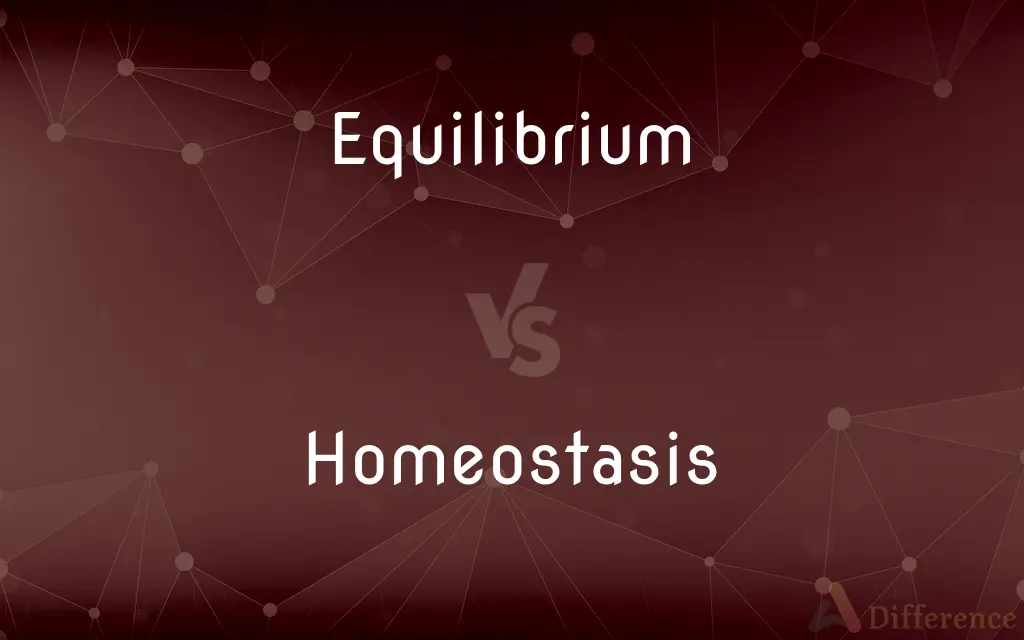Equilibrium vs. Homeostasis — What's the Difference?
By Urooj Arif & Maham Liaqat — Updated on March 15, 2024
Equilibrium denotes a state of balance between opposing forces, while homeostasis refers to the maintenance of stable internal conditions in living organisms.

Difference Between Equilibrium and Homeostasis
Table of Contents
ADVERTISEMENT
Key Differences
Equilibrium is a broad concept applicable in various scientific fields, including physics, chemistry, and economics, denoting a state where opposing forces are balanced, leading to stability. For instance, in physics, it refers to when an object is in a state where no external forces cause it to move. In contrast, homeostasis specifically relates to biological systems, describing the process by which living organisms regulate their internal environment to maintain a stable, constant condition, vital for survival.
While equilibrium can occur in both living and non-living systems and does not necessarily imply any regulatory mechanism to maintain balance, homeostasis is an active process. It involves complex biological mechanisms that constantly adjust to internal and external changes to preserve optimal conditions for cellular function and life. These mechanisms include temperature regulation, pH balancing, and the maintenance of glucose levels.
Equilibrium might be achieved and maintained passively, without any energy expenditure, as seen in chemical reactions reaching a state where reactants and products are formed at the same rate. On the other hand, homeostasis is an energy-requiring process, as living organisms must actively work to correct deviations from their desired internal state, employing feedback mechanisms to do so.
In essence, while both concepts deal with states of balance, the contexts in which they apply and the means by which balance is achieved differ significantly. Equilibrium is a more general notion of balance that can apply to a wide range of scenarios, whereas homeostasis is a specific biological process aimed at maintaining life by regulating an organism's internal environment.
The distinction between these two concepts is also evident in their applications and implications. Equilibrium can be applied to explain phenomena in non-living systems, such as the balance of forces in a static structure or the economic equilibrium in a market. Homeostasis, however, has profound implications for understanding health and disease in living organisms, as disruptions to homeostatic processes can lead to illness.
ADVERTISEMENT
Comparison Chart
Definition
State of balance between opposing forces
Regulation of stable internal conditions
Application
Physics, chemistry, economics
Biological systems
Energy Requirement
Not necessarily
Yes, requires energy
Mechanism
Passive or active
Active regulatory processes
Scope
Both living and non-living systems
Living organisms only
Example
Chemical equilibrium
Body temperature regulation
Compare with Definitions
Equilibrium
Equilibrium refers to a state of balance in a variety of contexts.
In a market equilibrium, supply equals demand.
Homeostasis
Active energy expenditure is required to maintain homeostasis.
Sweating to cool down involves energy use in response to overheating.
Equilibrium
Applies broadly across scientific disciplines.
Economic models often assume conditions of equilibrium.
Homeostasis
Homeostasis is the process of maintaining internal stability in organisms.
Humans maintain a constant body temperature through homeostasis.
Equilibrium
It can occur without any energy input, achieving stability passively.
A pendulum at rest is in mechanical equilibrium.
Homeostasis
Essential for survival, enabling organisms to adapt to changes.
Homeostatic mechanisms adjust to external temperatures to preserve core body warmth.
Equilibrium
Stability in equilibrium can be dynamic or static.
Dynamic equilibrium involves continuous movement but no overall change.
Homeostasis
Homeostasis is fundamental to health and disease understanding.
Disruptions in homeostasis can lead to diabetes or thyroid disorders.
Equilibrium
Equilibrium is essential for understanding physical and chemical processes.
Chemical equilibrium is reached when reactant and product rates are equal.
Homeostasis
In biology, homeostasis is the state of steady internal, physical, and chemical conditions maintained by living systems. This is the condition of optimal functioning for the organism and includes many variables, such as body temperature and fluid balance, being kept within certain pre-set limits (homeostatic range).
Equilibrium
A condition in which all acting influences are canceled by others, resulting in a stable, balanced, or unchanging system.
Homeostasis
A state of equilibrium, as in an organism or cell, maintained by self-regulating processes
The kidneys maintain homeostasis in the body by regulating the amount of salt and water excreted.
Equilibrium
Mental or emotional balance.
Homeostasis
Such a dynamic equilibrium or balance.
Equilibrium
(Physics) The state of a body or physical system at rest or in unaccelerated motion in which the resultant of all forces acting on it is zero and the sum of all torques about any axis is zero.
Homeostasis
Metabolic equilibrium actively maintained by several complex biological mechanisms that operate via the autonomic nervous system to offset disrupting changes
Equilibrium
The state of a chemical reaction in which its forward and reverse reactions occur at equal rates so that the concentration of the reactants and products does not change with time.
Equilibrium
The state of a system in which more than one phase exists and exchange between phases occurs at equal rates so that there is no net change in the composition of the system.
Equilibrium
The condition of a system in which competing influences are balanced, resulting in no net change.
Equilibrium
Mental balance.
Equilibrium
(chemistry) The state of a reaction in which the rates of the forward and reverse reactions are the same.
Equilibrium
(physics) The state of a body at rest or in uniform motion in which the resultant of all forces on it is zero.
Equilibrium
Equality of weight or force; an equipoise or a state of rest produced by the mutual counteraction of two or more forces.
Equilibrium
A level position; a just poise or balance in respect to an object, so that it remains firm; equipoise; as, to preserve the equilibrium of the body.
Health consists in the equilibrium between those two powers.
Equilibrium
A balancing of the mind between motives or reasons, with consequent indecision and doubt.
Equilibrium
A chemical reaction and its reverse proceed at equal rates
Equilibrium
A stable situation in which forces cancel one another
Equilibrium
Equality of distribution
Equilibrium
A sensory system located in structures of the inner ear that registers the orientation of the head
Common Curiosities
How does homeostasis affect an organism's health?
Proper homeostasis is crucial for health; disruptions can lead to diseases.
Can a system be in equilibrium and not exhibit homeostasis?
Yes, non-living systems can achieve equilibrium without the active regulatory mechanisms characteristic of homeostasis.
Is homeostasis only relevant to biological systems?
Yes, homeostasis specifically pertains to the regulation of internal conditions within living organisms.
What is the main difference between equilibrium and homeostasis?
Equilibrium is a general state of balance, while homeostasis is the maintenance of stable internal conditions in living organisms.
Can equilibrium apply to social systems?
Yes, social and economic theories use equilibrium to describe states of balance in relationships and markets.
How do feedback mechanisms relate to homeostasis?
Feedback mechanisms are crucial for homeostasis, helping to adjust internal conditions back to their set points.
What is an example of a dynamic equilibrium?
An example of dynamic equilibrium is the continuous exchange of water molecules between liquid water and water vapor in a closed container.
Is homeostasis ever fully achieved, or is it a constant process?
Homeostasis is a constant process, as organisms continuously adjust to internal and external changes to maintain stability.
Can equilibrium exist without any energy input?
Yes, equilibrium can be passive and require no energy input, unlike homeostasis.
What roles do energy play in maintaining equilibrium and homeostasis?
While equilibrium may not require energy, maintaining homeostasis requires active energy expenditure.
Can an economic system be considered in homeostasis?
No, economic systems can achieve equilibrium, but homeostasis is a term reserved for living biological systems.
How do organisms maintain homeostasis in extreme environments?
They employ specialized adaptations and mechanisms to regulate internal conditions despite external extremes.
Why is homeostasis important in exercise and sports?
During exercise, maintaining homeostasis, such as proper temperature and pH levels, is crucial for performance and health.
How does homeostasis relate to evolutionary adaptation?
Effective homeostatic mechanisms can be advantageous in evolution, allowing organisms to survive and reproduce in varying environments.
Share Your Discovery

Previous Comparison
Ken vs. Kin
Next Comparison
Speedy vs. SwiftAuthor Spotlight
Written by
Urooj ArifUrooj is a skilled content writer at Ask Difference, known for her exceptional ability to simplify complex topics into engaging and informative content. With a passion for research and a flair for clear, concise writing, she consistently delivers articles that resonate with our diverse audience.
Co-written by
Maham Liaqat















































